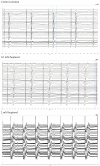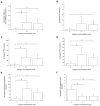Heterogeneities in Ventricular Conduction Following Treatment with Heptanol: A Multi-Electrode Array Study in Langendorff-Perfused Mouse Hearts
- PMID: 35888085
- PMCID: PMC9321110
- DOI: 10.3390/life12070996
Heterogeneities in Ventricular Conduction Following Treatment with Heptanol: A Multi-Electrode Array Study in Langendorff-Perfused Mouse Hearts
Abstract
Background: Previous studies have associated slowed ventricular conduction with the arrhythmogenesis mediated by the gap junction and sodium channel inhibitor heptanol in mouse hearts. However, they did not study the propagation patterns that might contribute to the arrhythmic substrate. This study used a multi-electrode array mapping technique to further investigate different conduction abnormalities in Langendorff-perfused mouse hearts exposed to 0.1 or 2 mM heptanol. Methods: Recordings were made from the left ventricular epicardium using multi-electrode arrays in spontaneously beating hearts during right ventricular 8 Hz pacing or S1S2 pacing. Results: In spontaneously beating hearts, heptanol at 0.1 and 2 mM significantly reduced the heart rate from 314 ± 25 to 189 ± 24 and 157 ± 7 bpm, respectively (ANOVA, p < 0.05 and p < 0.001). During regular 8 Hz pacing, the mean LATs were increased by 0.1 and 2 mM heptanol from 7.1 ± 2.2 ms to 19.9 ± 5.0 ms (p < 0.05) and 18.4 ± 5.7 ms (p < 0.05). The standard deviation of the mean LATs was increased from 2.5 ± 0.8 ms to 10.3 ± 4.0 ms and 8.0 ± 2.5 ms (p < 0.05), and the median of phase differences was increased from 1.7 ± 1.1 ms to 13.9 ± 7.8 ms and 12.1 ± 5.0 ms by 0.1 and 2 mM heptanol (p < 0.05). P5 took a value of 0.2 ± 0.1 ms and was not significantly altered by heptanol at 0.1 or 2 mM (1.1 ± 0.9 ms and 0.9 ± 0.5 ms, p > 0.05). P50 was increased from 7.3 ± 2.7 ms to 24.0 ± 12.0 ms by 0.1 mM heptanol and then to 22.5 ± 7.5 ms by 2 mM heptanol (p < 0.05). P95 was increased from 1.7 ± 1.1 ms to 13.9 ± 7.8 ms by 0.1 mM heptanol and to 12.1 ± 5.0 ms by 2 mM heptanol (p < 0.05). These changes led to increases in the absolute inhomogeneity in conduction (P5−95) from 7.1 ± 2.6 ms to 31.4 ± 11.3 ms, 2 mM: 21.6 ± 7.2 ms, respectively (p < 0.05). The inhomogeneity index (P5−95/P50) was significantly reduced from 3.7 ± 1.2 to 3.1 ± 0.8 by 0.1 mM and then to 3.3 ± 0.9 by 2 mM heptanol (p < 0.05). Conclusion: Increased activation latencies, reduced CVs, and the increased inhomogeneity index of conduction were associated with both spontaneous and induced ventricular arrhythmias.
Keywords: action potential duration; conduction; detrended fluctuation analysis; dispersion; entropy; heptanol; heterogeneity; hypokalemia; inhomogeneity; mouse; variability.
Conflict of interest statement
The authors declare no conflict of interest.
Figures







Similar articles
-
Gap junction inhibition by heptanol increases ventricular arrhythmogenicity by reducing conduction velocity without affecting repolarization properties or myocardial refractoriness in Langendorff-perfused mouse hearts.Mol Med Rep. 2016 Nov;14(5):4069-4074. doi: 10.3892/mmr.2016.5738. Epub 2016 Sep 13. Mol Med Rep. 2016. PMID: 27633494 Free PMC article.
-
Measures of repolarization variability predict ventricular arrhythmogenesis in heptanol-treated Langendorff-perfused mouse hearts.Curr Res Physiol. 2021 Apr 19;4:125-134. doi: 10.1016/j.crphys.2021.04.001. eCollection 2021. Curr Res Physiol. 2021. PMID: 34746832 Free PMC article.
-
Ventricular arrhythmogenesis following slowed conduction in heptanol-treated, Langendorff-perfused mouse hearts.J Physiol Sci. 2012 Mar;62(2):79-92. doi: 10.1007/s12576-011-0187-2. Epub 2012 Jan 5. J Physiol Sci. 2012. PMID: 22219003 Free PMC article.
-
Effects of pharmacological gap junction and sodium channel blockade on S1S2 restitution properties in Langendorff-perfused mouse hearts.Oncotarget. 2017 Jul 28;8(49):85341-85352. doi: 10.18632/oncotarget.19675. eCollection 2017 Oct 17. Oncotarget. 2017. PMID: 29156723 Free PMC article.
-
Atrial Anti-Arrhythmic Effects of Heptanol in Langendorff-Perfused Mouse Hearts.PLoS One. 2016 Feb 12;11(2):e0148858. doi: 10.1371/journal.pone.0148858. eCollection 2016. PLoS One. 2016. PMID: 26872148 Free PMC article.
Cited by
-
Sacubitril/Valsartan Ameliorates Crizotinib-Induced Cardiotoxicity in Mice.Rev Cardiovasc Med. 2023 Jul 3;24(7):192. doi: 10.31083/j.rcm2407192. eCollection 2023 Jul. Rev Cardiovasc Med. 2023. PMID: 39077026 Free PMC article.
-
Cardiac Tissue Engineering: A Journey from Scaffold Fabrication to In Vitro Characterization.Small Sci. 2024 Jul 22;4(9):2400079. doi: 10.1002/smsc.202400079. eCollection 2024 Sep. Small Sci. 2024. PMID: 40212070 Free PMC article.
-
Vector Field Heterogeneity for the Assessment of Locally Disorganised Cardiac Electrical Propagation Wavefronts From High-Density Multielectrodes.IEEE Open J Eng Med Biol. 2023 Dec 20;5:32-44. doi: 10.1109/OJEMB.2023.3344349. eCollection 2024. IEEE Open J Eng Med Biol. 2023. PMID: 38445238 Free PMC article.
-
Sevoflurane Improves Ventricular Conduction by Exosomes Derived from Rat Cardiac Fibroblasts After Hypothermic Global Ischemia-Reperfusion Injury.Drug Des Devel Ther. 2023 Jun 12;17:1719-1732. doi: 10.2147/DDDT.S408595. eCollection 2023. Drug Des Devel Ther. 2023. PMID: 37333963 Free PMC article.
References
-
- Tolppanen H., Siirila-Waris K., Harjola V.P., Marono D., Parenica J., Kreutzinger P., Nieminen T., Pavlusova M., Tarvasmaki T., Twerenbold R., et al. Ventricular conduction abnormalities as predictors of long-term survival in acute de novo and decompensated chronic heart failure. ESC Heart Fail. 2016;3:35–43. doi: 10.1002/ehf2.12068. - DOI - PMC - PubMed
LinkOut - more resources
Full Text Sources
Research Materials
Miscellaneous

